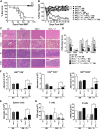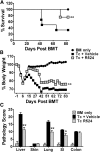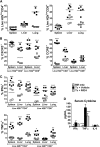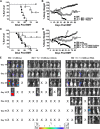Pharmacologic inhibition of PKCα and PKCθ prevents GVHD while preserving GVL activity in mice
- PMID: 23908466
- PMCID: PMC3790515
- DOI: 10.1182/blood-2012-12-471938
Pharmacologic inhibition of PKCα and PKCθ prevents GVHD while preserving GVL activity in mice
Abstract
Allogeneic hematopoietic cell transplantation (HCT) is the most effective therapy for hematopoietic malignancies through T-cell-mediated graft-vs-leukemia (GVL) effects but often leads to severe graft-vs-host disease (GVHD). Given that protein kinase Cθ (PKCθ), in cooperation with PKCα, is essential for T-cell signaling and function, we have evaluated PKCθ and PKCα as potential therapeutic targets in allogeneic HCT using genetic and pharmacologic approaches. We found that the ability of PKCα(-/-)/θ(-/-) donor T cells to induce GVHD was further reduced compared with PKCθ(-/-) T cells in relation with the relevance of both isoforms to allogeneic donor T-cell proliferation, cytokine production, and migration to GVHD target organs. Treatment with a specific inhibitor for both PKCθ and PKCα impaired donor T-cell proliferation, migration, and chemokine/cytokine production and significantly decreased GVHD in myeloablative preclinical murine models of allogeneic HCT. Moreover, pharmacologic inhibition of PKCθ and PKCα spared T-cell cytotoxic function and GVL effects. Our findings indicate that PKCα and θ contribute to T-cell activation with overlapping functions essential for GVHD induction while less critical to the GVL effect. Thus, targeting PKCα and PKCθ signaling with pharmacologic inhibitors presents a therapeutic option for GVHD prevention while largely preserving the GVL activity in patients receiving HCT.
Figures







Comment in
-
Doubling down on PKC benefits allogeneic BMT.Blood. 2013 Oct 3;122(14):2298-9. doi: 10.1182/blood-2013-08-519900. Blood. 2013. PMID: 24092926 Free PMC article.
Similar articles
-
PKCtheta is required for alloreactivity and GVHD but not for immune responses toward leukemia and infection in mice.J Clin Invest. 2009 Dec;119(12):3774-86. doi: 10.1172/JCI39692. Epub 2009 Nov 9. J Clin Invest. 2009. PMID: 19907075 Free PMC article.
-
Tolerogenic anti-IL-2 mAb prevents graft-versus-host disease while preserving strong graft-versus-leukemia activity.Blood. 2021 Apr 22;137(16):2243-2255. doi: 10.1182/blood.2020006345. Blood. 2021. PMID: 33511398 Free PMC article.
-
Daratumumab Prevents Experimental Xenogeneic Graft-Versus-Host Disease by Skewing Proportions of T Cell Functional Subsets and Inhibiting T Cell Activation and Migration.Front Immunol. 2021 Dec 20;12:785774. doi: 10.3389/fimmu.2021.785774. eCollection 2021. Front Immunol. 2021. PMID: 34987512 Free PMC article.
-
Th2 and Tc2 cells in the regulation of GVHD, GVL, and graft rejection: considerations for the allogeneic transplantation therapy of leukemia and lymphoma.Leuk Lymphoma. 2000 Jul;38(3-4):221-34. doi: 10.3109/10428190009087014. Leuk Lymphoma. 2000. PMID: 10830730 Review.
-
Retention of Donor T Cells in Lymphohematopoietic Tissue and Augmentation of Tissue PD-L1 Protection for Prevention of GVHD While Preserving GVL Activity.Front Immunol. 2022 May 23;13:907673. doi: 10.3389/fimmu.2022.907673. eCollection 2022. Front Immunol. 2022. PMID: 35677056 Free PMC article. Review.
Cited by
-
Advances and challenges in immunotherapy for solid organ and hematopoietic stem cell transplantation.Sci Transl Med. 2015 Mar 25;7(280):280rv2. doi: 10.1126/scitranslmed.aaa6853. Sci Transl Med. 2015. PMID: 25810312 Free PMC article. Review.
-
DOT1L inhibition attenuates graft-versus-host disease by allogeneic T cells in adoptive immunotherapy models.Nat Commun. 2018 May 15;9(1):1915. doi: 10.1038/s41467-018-04262-0. Nat Commun. 2018. PMID: 29765028 Free PMC article.
-
Treatment with a rho kinase inhibitor improves survival from graft-versus-host disease in mice after MHC-haploidentical hematopoietic cell transplantation.Biol Blood Marrow Transplant. 2014 Aug;20(8):1104-11. doi: 10.1016/j.bbmt.2014.04.029. Epub 2014 May 2. Biol Blood Marrow Transplant. 2014. PMID: 24796280 Free PMC article.
-
Immunomodulation of Selective Naive T Cell Functions by p110δ Inactivation Improves the Outcome of Mismatched Cell Transplantation.Cell Rep. 2015 Feb 10;10(5):702-710. doi: 10.1016/j.celrep.2015.01.002. Epub 2015 Feb 5. Cell Rep. 2015. PMID: 25660021 Free PMC article.
-
Virotherapy as Potential Adjunct Therapy for Graft-Vs-Host Disease.Curr Pathobiol Rep. 2018;6(4):247-263. doi: 10.1007/s40139-018-0186-6. Epub 2018 Nov 19. Curr Pathobiol Rep. 2018. PMID: 30595970 Free PMC article. Review.
References
-
- Dustin ML. PKC-θ: hitting the bull’s eye. Nat Immunol. 2011;12(11):1031–1032. - PubMed
Publication types
MeSH terms
Substances
Grants and funding
LinkOut - more resources
Full Text Sources
Other Literature Sources
Molecular Biology Databases

